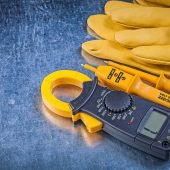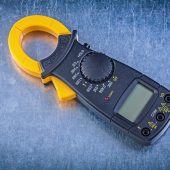Diodes are tiny by important components normally found on circuit boards. Their main function is to control the flow of current to ensure it only goes in one direction. They are like water valves that allow water to flow one way only.
Diodes are also used to transform AC current into DC current. In that application, they are called rectifiers.
In this post, we discuss how to test a diode with a multimeter. This test will tell you whether a diode is working properly.
How Diodes Work: A Brief Summary
To properly test a diode and understand the results you are seeing on the multimeter, it’s important to have a basic understanding of how diodes work.
You can skip this part if you are already familiar with them.
A regular diode consists of the main body with two thin wires on either side of it. The body of a diode has polarity – meaning there’s a positive (anode) and negative (cathode) side. You can tell which side is which by the location of a strip around one end of the diode.
The band or strip is on the cathode terminal of the diode. Current always flows towards the strip, never the other way.
And that’s how a diode works as a one-way switch. When current is applied on the anode side, it allows current to flow through. This is called forward bias.
When it is reversed and current is applied on the cathode terminal, it blocks current from passing through. This is called reverse bias.
When you are testing a diode, you are essentially checking whether current is flowing in one direction only. If there’s a two-way flow, then the diode is bad.
How To Test If A Diode Is Working With A Digital Multimeter
A circuit board has so many components that figuring out which one is causing a problem can be challenging. Resistors, capacitors, inductors, diodes — any one of this could be the issue.
Fortunately, a digital multimeter (and probably an LCR meter as well) is usually all you need to carry out diagnostic tests. It’s also what we are going to use to test diodes.
You usually can’t tell a diode is bad just by looking at it. Sometimes you might be lucky and see some scorch marks indicating a diode has overheated. Other times, a bad diode might be cracked.
But often, a multimeter diode test is the only way to diagnose a bad diode.
Setting Up Your Multimeter
You can certainly use an analog multimeter, but a digital multimeter is easier to use and more accurate.
Make sure your multimeter is working properly and the batteries are good. A quick way to check that your multimeter and the leads are functioning is to set the dial to continuity mode and then touch the leads together.
You should hear a continuous beep from the multimeter, confirming that it’s working.
To test a diode, set the multimeter to the dial test mode. It’s the one with the diode symbol (an arrow with a horizontal line going through it and another short vertical line at its tip).
Make sure the leads are in the right place: black in the COM socket and red in the V/Ω socket.
De-solder The Diode
Before you test a diode, it’s a good idea to remove it from the circuit board. Yes, it’s an extra step and you’ll need to de-solder the diode. But it will give you the most accurate results. You can also try using needle nose pliers or tweezers to break the diode off the circuit board.
A diode connected to a circuit board might indicate voltage on both terminals. This can be because the diode is bad or there could be another source of voltage.
Even when you turn off power to the circuit boards, components like capacitors might still have some charge left.
If you cannot remove a diode from the board, take these steps to ensure an accurate test.
- Cut off power to the circuit board.
- Discharge any components such as capacitors and inductors.
- Make sure the multimeter leads don’t touch any other part of the board during the test. The leads should only touch the wires on either side of the diode.
Testing The Diode In Forward & Reverse Bias
To start the test, first identify the anode and cathode terminals of the diode. Remember the side with the strip is the cathode and current flows towards that direction.
Touch the red (positive) lead of the multimeter on the anode side of the diode and the black (negative) lead on the cathode side.
Check the display on the multimeter.
If the diode is working properly, you should get a voltage reading of between 0.5 and 0.7. That’s called the voltage drop. Check your diode specs for the exact voltage drop to expect. Some diodes have higher or lower voltage drop than this.
The voltage drop is the amount of voltage needed to allow current to flow through the diode while it is in forward bias. It’s like the amount of power required to flip the switch.
Tip: If you get an OL reading on the multimeter, you’ve probably reversed the polarity of the diode. Reverse the diode and test again.
Next, we need to test the diode in reverse bias. To do this, you can reverse the diode or switch the leads.
You need to have the red lead on the cathode side and the black lead on the anode side. This test attempts to get current to flow from the negative side of the diode to the positive side.
Do the test and check the multimeter display. You should get an OL reading.
This means there is infinite resistance and current cannot flow through the diode. That’s what you want to see and it indicates the diode is good.
Analysing A Diode Test
- As we’ve discussed above, if the diode is good, you should get a 0.5-0.7V reading in forward bias and an OL reading in reverse bias. Again, confirm the voltage drop of your specific diode as some diodes are different.
- If you get a voltage drop of 0 to 0.4V when you measure in both the forward and reverse bias, the diode is bad. It’s called a shorted diode. It’s allowing current to flow freely in both directions.
- If you get an OL reading in both the forward and reverse bias, the diode is also bad. It’s called an open diode. It doesn’t allow current to flow in either direction.
Here’s an easy to follow video that summarises the entire diode test process.
How To Test A Diode’s Resistance With A Multimeter
If your multimeter doesn’t have a diode test mode or you want to carry out further tests on a diode, you can use the resistance mode on a digital multimeter.
A good diode will indicate low resistance in forward bias and very high resistance in reverse bias.
Set up your multimeter and select the resistance mode. It’s the one with the ohms symbol (Ω). Select the lowest ohm value.
Test the diode, making sure the red lead is on the positive side of the diode and the black lead is on the negative.
You should get a reading between 10Ω and 1000Ω. That’s very low resistance and it indicates that current is flowing through the diode.
Repeat the test while the diode is in reverse bias. The multimeter should show an OL reading, meaning infinite resistance. That indicates there is no current flowing from the cathode to the anode.
- If you get a reading in forward and reverse bias, that diode is shorted and is allowing current to flow in either direction.
- If you get an OL reading in forward and reverse bias, that diode is open and is blocking current flow in either direction.
Can You Test A Diode In Continuity Mode?
Continuity mode may seem like a perfectly okay way to test a diode. After all, you are checking whether current can pass through it.
But never test a diode in continuity mode. This mode can force a current that’s too high through a diode and damage it.
A diode that was good may start testing as an open or shorted diode. Only use the diode test mode or the resistance mode.
What makes Diodes Go Bad
If you are constantly getting bad diodes, you may be wondering what’s happening.
Diodes go bad for two main reasons: too much forward current or high reverse voltage.
Too much current flowing through the diode will usually cause it to fail open. This blocks current flow towards either direction of the diode – in other words, it creates an open/incomplete circuit.
Overvoltage will often cause the diode to short circuit such that it acts as a normal conductor, allowing current to flow in either direction.
In some cases, too much current or voltage can cause diodes to burn or even explode.
There are plenty of possible causes of overcurrent or overvoltage in a circuit including a faulty power supply, power surge, a ground fault, excessive load and so on.
Before you replace a bad diode, it’s important identify why it failed so that it doesn’t happen again.


